
What’s the difference between a villain and an antagonist?
Google “antagonist vs villain” and you get over 300 million hits. I did a review of page 1 of the search, since everyone knows you never venture into the forbidden wastes of Page 2 of Search Result Land. Conclusion: There are definite differences between antagonists and villains, but there’s a lot of line blurring too.
Before I jump into analyzing words, I like to get their meanings straight from the source: Merriam-Webster. Here we go:
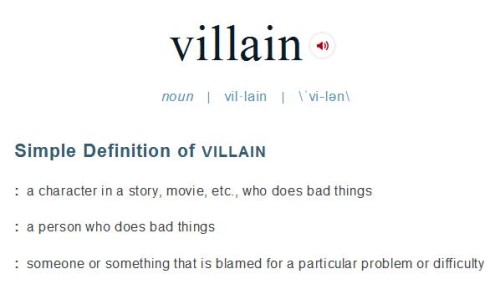
Full Definition of villain
- 1 : villein
- 2 : an uncouth person : boor
- 3 : a deliberate scoundrel or criminal
- 4 : a character in a story or play who opposes the hero
- 5 : one blamed for a particular evil or difficulty <automation as the villain in job … displacement — M. H. Goldberg

Full Definition of antagonist
- 2 : an agent of physiological antagonism: as a : a muscle that contracts with and limits the action of an agonist with which it is paired —called also antagonistic muscle b : a chemical that acts within the body to reduce the physiological activity of another chemical substance (as an opiate); especially : one that opposes the action on the nervous system of a drug or a substance occurring naturally in the body by combining with and blocking its nervous receptor — compare agonist 2b
There you have it. End of the article, thanks for reading, goodnight- But wait! There’s more! Let’s break this down.
-
♦ There is a difference between Antagonists and Villains.
Look closely: A villain is a character/person who does bad things. An antagonist is simply a person who opposes another person. Whether a character is an antagonist or not all depends on which end we’re reading the story from.
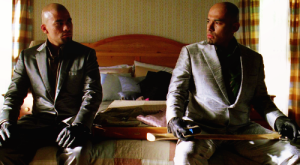
Take Breaking Bad* for example. If we were watching it from the meth cook’s standpoint, the DEA agent is the antagonist. If we’re watching it from the DEA agent’s POV, the criminal lawyer is the antagonist. No matter how we look at it, the vengeance-minded Cartel cousins who kill anyone who gets in their way are the villains.
-
♦ It’s about the heart and intent.
A villain is a deliberate scoundrel or criminal. An antagonist is one that contends with or opposes another. They’re an adversary and/or opponent.
Diving deeper into the dark:
What is a villain?
Villain – short definition:
an individual who stands against the aims of the hero by exercising a villainous life nature in ways that are tricky, illegal, or just plain mean spirited and if left unchecked will cause harm, usually to the hero/protagonist. They may be described as EVIL.
A devil.
What is an antagonist?
Antagonist – short definition:
an individual who stands against the aims of the hero but not necessarily by exercising a villainous life nature in a destructive way. They are rarely described as EVIL, even if they are dangerous.
A rival.
Semi-same side: an antagonist may be fighting for the same thing as the hero.

Consider Alexander Anderson in Hellsing, who is bent on ridding the world of the undead, just like Team Hellsing* is. Too bad Alucard, Hellsing’s lead agent, is a vampire. The villain of the series is the Major, a Nazi bent on throwing the world into war and chaos so he can face his greatest challenge, Alucard.
Or think of Draco Malfoy, an antagonist, vs Voldemort, a villain.
Gollum = antag. Sauron = villain.
If we’re rooting for an outlaw protagonist, such as in Breaking Bad or Ocean’s Eleven* or Catch Me If You Can
*, the antagonist is often a law enforcement officer.
Center of attention: who’s in the spotlight?
Villains are often the star of the show for the dark side. They’re the main attraction, or at least trying to be. They might work together, but they still follow their own agendas primarily.
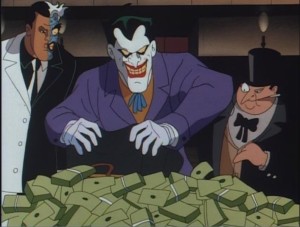
Example: the Joker, Penguin, and Twoface teaming up to stop Batman*.
Antags may play a subordinate or supporting role to the villain. Some may be lieutenants, while other are freelance but allying with the villain.
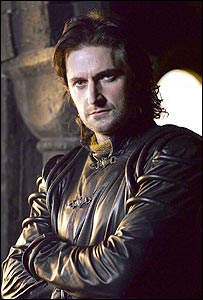
Example: Guy of Gisborne, the Sheriff of Nottingham’s lieutenant in BBC’s Robin Hood*.
State of mind: crazy like a fox, or dumb like a moose?
Villains often seem to have a mental illness. Usually it’s antisocial personality disorder, where the villain doesn’t give a crap about anybody else. Narcissism is also popular, as is borderline personality. The former is more common in female villains, though.
Antags are usually among the sanest people around; they just have interests that oppose the hero’s. Sometimes it’s the antagonist’s common sense or devotion to the rules that acts against the protagonist’s plans.
Eeeeeeviiiiil: black, white, or gray?
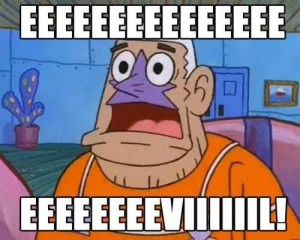
Villains are often described as “evil,” which usually means they’re not only OK with but quite happy to hurt and/or kill to get their way. Many times, harming and killing are either the goal or a major attraction of the goal. Think Joker blowing up a hospital*. They may love “gratuitous violence,” relax by torturing heroes, and drink their GMO grape juice out their enemies’ skulls. The Evil Overlord is the classic villain. Spikes and skulls are decor themes, with black as a color base and slime green, halloween purple, and/or arterial red as accents. Think Darken Rahl in the Terry Goodkind’s Sword of Truth
* books or the Legend of the Seeker
* TV series.
The antagonist isn’t usually so “obviously” evil. An antagonist is ready and willing to go over the top, out of their way, over the river and through the woods in order to get their goal, but usually won’t cause harm for the sake of harm.
They often look normal or even admirable to the outside viewer. It’s only their opposition to the hero that sets them in the antag role. Think Hank Schrader in Breaking Bad. He’s a DEA agent who’s devoted to catching the bad guy and is highly skilled at his job.
Salvage operation: any sign of humanity?
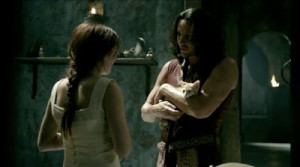
Villains often have no redeeming characteristics. Just when you think there might have a glimmer of hope, they’ll kill a kitten or kick a puppy. And we all know that while you can get away with slaughtering thousands of humans without much audience hate, may heaven have mercy on your soul of you harm a fluffy critter, because the audience won’t! I’m guilty of this value system too.
Antagonists have at least a few “humanizing qualities.” They have true Pet the Dog moments. You can picture them coming to the protagonist’s side if they could just see “reason.” Usually, anyway. And if they die, you might even shed a tear.
Hope and change: truth or fiction?
Villains will rarely experience a real change of heart/loyalties. They make fake being on the protag’s side, but it’s only to achieve an advantage. Only a massive transformation – or blow to the head – is capable of causing true change. Even then, it’s always in doubt.
Antagonists often do ally with the hero, especially if they’re fighting for the same cause as the protag. It’s just a matter of showing them that the protag’s way is better or acceptable after all.
This doesn’t mean villains are shallow compared to antagonists. It means villains’ methods are more ingrained. Their beliefs are usually rock solid. They may work with the hero for a brief time in order to advance their own ends, but the truce won’t last. Antagonists, however, may genuinely “see the light” and join the hero.
KABOOM!
Villains can stray easily into “comic book campy” territory. Flashy costumes; ridiculous schemes that border or, or flat or are, nuts; henchmen in outfits no self-respecting criminal would be caught dead in.

Antagonists feel more realistic. They’re either normal people or mostly normal. They’re not usually as powerful as the villain. If they are, they have more restraint in their use of power against the protag. Example: though David Xanatos in Gargoyles* is a billionaire and has had many opportunities to destroy the gargoyles, he doesn’t, because he finds them useful and entertaining.
View to a kill: Die hard?
Villains usually have Joker Immunity. Big Bads and Main Bosses are the movers and shakers, not to mention audience favorites. You don’t kill Joker, because he’s a huge part of the franchise. You might as well kill Batman! Killing off a long-standing villain means an irrevocable change in the series, something that rarely happens. It’s incredibly hard to do well, too.
Antagonists may be killed off more easily than villains. I don’t mean the hero defeats them for good more easily. I mean they’re more expendable from a franchise/series perspective.
Doing and being: traits vs role?
Villain describes traits and level of threat or evil in a story, while antagonist refers to a role/position, that of opposing the hero and giving the hero something to fight against. Specifically, the antagonist makes a plot possible.
An antagonist doesn’t have to be a sentient entity.
- Protagonist vs. Another Character (villain)
- Protagonist vs. Nature
- Protagonist vs. Society
- Protagonist vs. Technology
- Protagonist vs. Supernatural Forces
- Protagonist vs. Self
Source: diyMFA
What about this blog?
You’ll notice that we use Villain in our name and byline. Why? Am I contradicting what I just said above? No. If you read the reports and matrix scores, you’ll notice I’ll point out if they’re antagonists or villains. So why do I focus on villains in my front page? It’s not just because typing VILLAIN is quicker than typing ANTAGONIST. It’s because in common parlance, villain and antagonist are synonymous. And because at times the lines between antagonists and villains blur. Heck, we all have a little villain in us. We all have a villainous life nature if we look hard into the dark corners of our hearts.
Sources:
ladygeekgirl.wordpress.com: Antagonists vs. Villains vs. Anti-Villains
writerandproud.blogspot.com: The Difference Between Villains and Antagonists
diymfa.com: Villains vs. Antagonists
www.twistedjenius.com: Difference Between Villains and Antagonists
saskromancewriters.com: Villain or Antagonist? The Semantics
narrativefirst.com: Protagonist and Antagonist: Beyond Hero and Villain
kayedacus.com: Bad Guys: Antagonist or Villain?
www.sfnovelists.com: Villains vs. antagonists
♦ Further reading:
Villain Matrix Stats: Jareth the Goblin King – Labyrinth
Villain Matrix Stats: James “Jim” Moriarty – Sherlock
Agree? Disagree? Let us know in the comments. Perform your own villain assessment with the Villain Matrix. Use the Villain Matrix spreadsheet that come free when you join the Research Team, where you’ll also get our newsletter with its exclusive updates and content.
(*Affiliate link, meaning you get a movie, I get a few pennies, and everybody’s happy!)